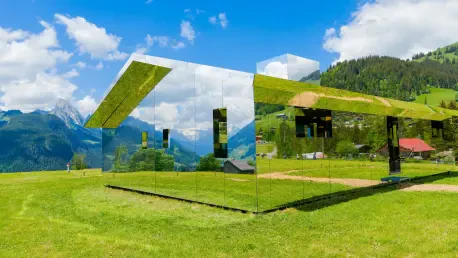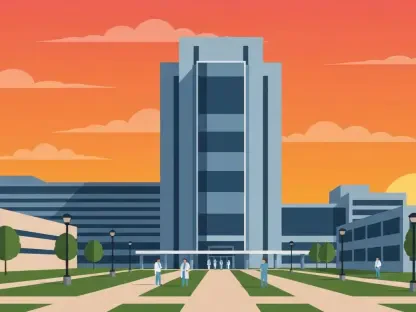With urbanization accelerating globally and climate change posing unprecedented challenges, the construction sector faces increasing pressure to evolve by integrating sustainable practices within the architecture industry. Futureproof buildings, designed with resilience against climate impacts and technological adaptability, promise a proactive approach. However, making these structures the norm involves overcoming several systemic barriers, including regulatory difficulties and societal resistance. The key lies in aligning environmental stewardship with urban development goals to ensure cities can effectively meet the demands of a changing world.
Defining the Futureproof Building
Adaptive Design and Technology Integration
Modern buildings must be flexible enough to incorporate emerging technologies and respond to climate effects such as heatwaves and heavy rainfall. Flexibility ensures structures can meet current and future demands, thereby maintaining their relevancy and utility over time. Emphasizing the use of recyclable and sustainable materials reduces carbon emissions, promoting a circular economy where resources are conserved and reused wisely. Integrating biodiversity into architectural design enhances ecological balance and fortifies urban spaces against environmental stress. These principles are pivotal in constructing buildings capable of thriving amid unforeseen challenges.
Futureproof buildings require innovative designs that prioritize energy efficiency and sustainability. They are constructed using resource-efficient practices that minimize environmental footprints and mitigate carbon emissions. Adaptive structures equipped with smart technologies facilitate real-time monitoring and management of resource consumption, ensuring operational efficiency. Moreover, these buildings incorporate natural elements, such as green roofs and vertical gardens, to improve air quality and contribute to overall urban biodiversity, thus reinforcing their resilience and longevity in the face of climatic shifts.
Examples of Successful Projects
The Floating University Berlin exemplifies adaptive architecture through its utilization of a rainwater retention basin at the former Tempelhof Airport. Developed primarily with recycled materials, this transformative project by the architectural collective Raumlabor hosts a variety of educational formats and transdisciplinary activities, continually enhancing urban resilience. Another hallmark of futureproof design is the heat action plan in Burscheid, which focuses on reducing heat stress through increased green spaces and improved water management. This plan, developed in partnership with Buro Happold, showcases effective adaptive urban planning strategies.
The Neue Mitte Tempelhof in Berlin demonstrates comprehensive sustainability efforts through its planned urban quarter conversion. Key aspects of this project include reorganizing public facilities, creating housing, and enhancing green spaces, all while reusing existing building components and materials. Such projects emphasize the importance of ecological and social balance alongside modern mobility solutions. These initiatives aim for long-term community and environmental benefits, setting benchmarks for future developments.
Construction Phase and Operational Practices
Leveraging Renewable Resources
Innovations like the Anna Lindh House in Berlin exemplify how the construction phase can be optimized for sustainability. By employing timber-hybrid construction and CO₂-reduced concrete, the building significantly lowers emissions, operating with CO₂-neutral status. This approach underscores the efficacy of renewable resources in reducing the carbon footprint compared to conventional buildings. Buro Happold’s management team supports this initiative by implementing scientifically grounded strategies for emissions throughout the entire construction process, ensuring not only compliance but also measurable impact.
Attention to sustainable practices extends beyond construction to the ongoing operation of these buildings. Techniques such as smart metering enable continuous monitoring of energy usage, allowing adjustments that enhance efficiency. Incorporation of renewable energy sources, such as solar panels, further supports sustainability goals. By focusing on these methods, buildings can maintain CO₂-neutral operations, aligning with broader goals of reducing overall environmental impact and fostering resilience.
Biodiversity and Energy Efficiency
A notable example of leveraging biodiversity with energy-efficient practices is illustrated by the Brainergy Hub in Jülich. The center for sustainable energy research and innovation combines a hybrid timber and concrete structure with surrounding green spaces. This integration promotes biodiversity, offering habitats for various species and enriching the ecological landscape. Photovoltaic panels installed at the site generate electricity, with rainwater management systems in place to support energy needs, creating a symbiotic relationship between the built environment and nature.
The harmonious relationship between building design and natural elements in projects like Brainergy Hub highlights the potential for energy-efficient practices to coexist with biodiversity promotion. By ensuring these aspects are incorporated, such buildings contribute positively to urban ecology while also achieving sustainable energy objectives. These initiatives provide a roadmap for designing futureproof buildings that effectively balance human needs with environmental considerations.
Overcoming Barriers to Widespread Adoption
Regulatory and Financial Challenges
The journey toward making futureproof buildings standard practice involves navigating through regulatory frameworks and societal reluctance. Complex regulations, outdated practices, and material shortages present significant hurdles. Bureaucratic processes often stifle momentum, despite the availability of technical solutions and pioneering examples. Efficiency House standards supported by governmental programs, such as those from KfW, offer financial incentives for energy-efficient construction and renovation. However, challenges remain as legal regulations and global standards are often misaligned, leading to cumbersome administrative processes and increased costs for developers.
Financial barriers continue to impede widespread adoption, with many sustainable building practices facing high upfront expenses due to the lack of comprehensive financing solutions. Developers find it difficult to prioritize sustainability without facing excessive administrative burdens. A lack of skilled labor further complicates efforts to implement sustainable materials on a large scale. Addressing these issues requires a multifaceted approach that bridges the gap between economic viability and environmental goals, ensuring futureproof structures become commonplace in urban landscapes.
Solutions Through Collaboration
Collaboration across the construction sector is vital to achieving significant progress toward normalizing sustainable practices. Initiatives like the Circular Economy focus on resource efficiency and consumption reduction, proving essential for broad adoption. Prioritizing carbon assessment early in projects and fostering open knowledge-sharing among stakeholders will cultivate an environment conducive to integrating sustainable practices. Ensuring stable, clear, and reliable regulations is fundamental to encouraging more projects focused on renovating existing buildings, where substantial environmental impact can be mitigated.
The construction sector’s stakeholders must commit to continuous improvement, aligning incentives with ecological goals. Cohesive strategies that balance urban development with environmental stewardship will aid in making futureproof buildings the norm. Establishing pathways for collaboration and sharing best practices is integral to overcoming barriers and ensuring cities are ready to address the evolving demands of an ever-changing world.
Toward a Sustainable Future
As rapid urbanization continues worldwide and climate change presents unparalleled challenges, the construction industry faces mounting pressure to evolve. Cities around the globe must swiftly adapt to shifting environmental conditions, making the incorporation of sustainable practices in architecture increasingly crucial. Futureproof buildings are conceptually designed to withstand climate impacts and embrace technological advancements, offering a forward-looking solution. Yet, transitioning these groundbreaking structures into standard practice is hindered by numerous systemic obstacles, such as regulatory hurdles and societal resistance to change. The main challenge lies in harmonizing environmental sustainability with urban development objectives to ensure that cities can adequately address the demands of an ever-transforming world. To achieve this, architects and planners must work collaboratively with policymakers to reform regulations that inhibit progress, while fostering community engagement to build support for sustainable initiatives. By doing so, cities can not only embrace resilience but also thrive amidst the uncertainties of climate change, paving the way for a more sustainable and adaptable urban future.









